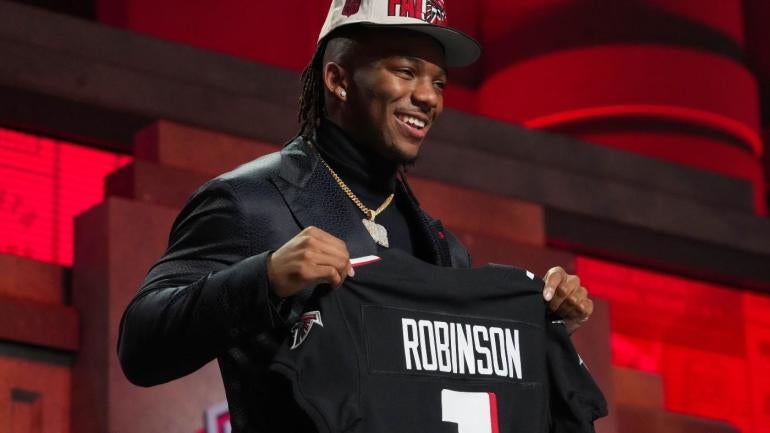
In last weekend's NFL Draft, two of the most controversial picks were those of Bijan Robinson and Jahmyr Gibbs. Both players are running backs, and Robinson was selected No. 8 overall by the Atlanta Falcons, while Gibbs was tabbed by the Detroit Lions with the No. 12 overall pick.
Given what we now know about the value of running backs -- and of running the ball -- in the modern NFL, it is increasingly out of vogue to draft a running back early, let alone in the top half of the first round. And yet, two teams did just that. Perhaps coincidentally and perhaps not, the Falcons and Lions appear to have the same rationale for their selections.
You see, Robinson and Gibbs are not running backs, according to the teams that drafted them.
Sports Illustrated noted that "the Falcons didn't see Robinson as a tailback. They saw him as another queen on the chessboard for an offense that's stockpiling them." Lions general manager Brad Holmes, meanwhile, declared of Gibbs, "We didn't acquire a running back in the first round. We acquired an elite weapon to keep our offense explosive."
You might recognize the rationale because it's basically the same thing any team that drafts a running back "too early" these days has to say in the post-draft media availability. What else are they going to say? Something like this?

Anyway, the idea is that Robinson and Gibbs are so versatile and so explosive that you don't have to just play them in the backfield and hand them the ball. You can throw them the ball, and you can line them up anywhere -- including in the slot or even out wide. The issue there is, well, that is just not really a thing that happens.
For example, according to Pro Football Focus, Robinson lined up slot or wide on just 32 snaps last season at Texas. That's 2.7 snaps per game. Gibbs lined up there considerably more often, but even he did it on just 90 occasions, or 7.5 snaps per game. You might think their NFL teams will utilize them in that fashion considerably more often, but the Falcons and Lions would have to dramatically scale up the usage of running backs in locations outside the backfield from where it has been in recent NFL history.
Since 2017, just three times has a running back lined up in the slot or out wide for at least 10 snaps per game: Christian McCaffrey in 2017, Tarik Cohen in 2019, and J.D. McKissic in 2020. That's it. Cohen and McKissic were part-time players whose roles were near-exclusively about receiving, while that 2017 McCaffrey season was his rookie year, before he became Carolina's full-time starter at running back. Even last season, with McCaffrey playing under position-less football aficionado Kyle Shanahan in San Francisco, he totaled just 108 slot or wide snaps in 17 games (6.4 per game), and that figure led all running backs league-wide.
In other words, the high-level usage of running backs as slot or wide receivers mostly just does not happen. (And there's a reason for this: Actual wide receivers and even tight ends are just better at it, for the most part. To wit: The single-season running back leader in receptions merely 5 or more yards downfield is Jalen Richard, with a grand total of 21 of them in 2018.) And yet, this is part of the rationale for teams selecting them in the top half of the draft this year.
It's entirely possible -- perhaps even likely -- that Robinson and/or Gibbs become very good players. Maybe they even wind up All-Pros, or among the best running backs of all time. The might even contribute at a high level, or merely be useful pieces in the passing game. It's just highly unlikely that they will be the all-purpose weapons that line up all over the place that their teams apparently envision, unless their offensive coordinators are about to revolutionize the way NFL offense is played.
















